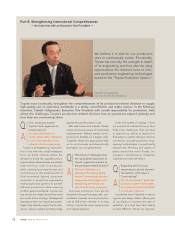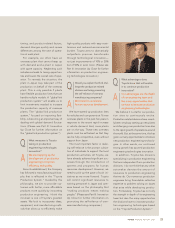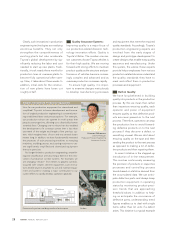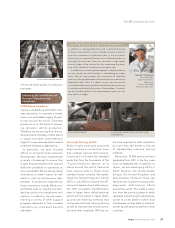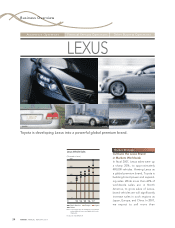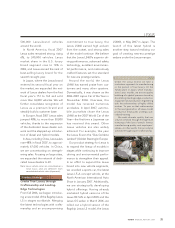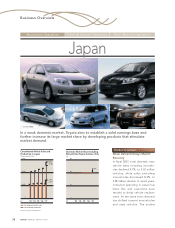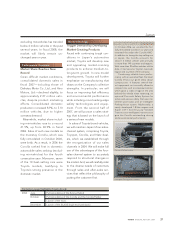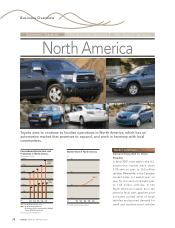Toyota 2007 Annual Report Download - page 31
Download and view the complete annual report
Please find page 31 of the 2007 Toyota annual report below. You can navigate through the pages in the report by either clicking on the pages listed below, or by using the keyword search tool below to find specific information within the annual report.
Part III: Innovation Up Close
of how we build quality in production
processes.
Advancing the Self-Reliance of
Overseas Manufacturing
Companies
Self-Reliance Promotion:
Toyota is establishing self-reliant over-
seas operations to maintain a timely,
lower-cost, and stabler supply of quali-
ty cars around the world. Overseas
production is on the brink of surpass-
ing domestic vehicle production.
Therefore, we are moving from the tra-
ditional system whereby mother plants
in Japan provided comprehensive
support to new overseas plants toward
a network of global collaborations.
In particular, we have focused
efforts on prompt human resources
development. We have implemented
a variety of measures to ensure that
locally employed personnel acquire
skills and contribute to operations as
soon as possible. We are also pursuing
innovations to make it easier for new
plants to start up and become inde-
pendent. In production engineering,
those innovations include efforts on a
worldwide scale to simplify and stan-
dardize production equipment and
systems. In addition, we are imple-
menting a variety of other support
programs designed to help overseas
manufacturing companies become
self-reliant.
Personnel Training at GPC:
Before locally employed personnel
begin working on production lines,
they undergo rigorous skills training.
Toyota has inculcated the standard
works that form the foundation of the
“Toyota Production System” at its
plants around the world. Personnel
must acquire skills to follow those
standard works correctly. We estab-
lished the Global Production Center
(GPC) in July 2003 to improve the effi-
ciency and speed of such skills acquisi-
tion. GPC is located in the Motomachi
plant in Japan. Here, skilled technical
personnel from plants in Japan devel-
op and use teaching methods that
incorporate technical training devices
as well as manuals that include anima-
tion and other visual aids. GPC has cut
the time required for skills acquisition
by more than half thanks to the use
of standardized intensive training
methods.
More than 10,000 personnel have
graduated from GPC in the four years
since its establishment. In addition to
Japan, we are developing GPCs in
North America, the United States;
Europe, the United Kingdom; and
Asia-Oceania, Thailand. These new
facilities are implementing parallel,
large-scale skills-training efforts
around the world. This marks a transi-
tion from the previous phase in which
Japanese trainers taught overseas per-
sonnel to a new phase in which local
trainers pass on their skills to local per-
sonnel as well as personnel from other
countries.
ANNUAL REPORT 2007 29
In-line measurement process
Tetsuaki Yoshikawa
General Manager
Engineering Service
Department
Tsutsumi Plant Body
Manufacturing Division
Controlling Processes through In-Line Measurement
In addition to rejecting defective parts, a distinctive feature
of in-line measurement is that it enables process control to
stop the occurrence of defective parts in the first place.
Previously, we measured the precision of vehicle bodies, an
assembly line end item. Now, we can build in high quality
at each stage of the process by also measuring the preci-
sion of the vehicle at several points along the way.
In addition, by monitoring trend figures in daily production,
we can quickly see which process is developing an irregu-
larity. We can then prevent the occurrence of defective
parts by making adjustments before the process reaches its
threshold value. Also, if a defect occurs, we can use the
accumulated data from upstream and downstream processes
to analyze and identify the cause of the problem. Currently,
we are introducing the in-line measurement system at over-
seas plants in stages.
In-line measurement In-line measurement (measurement using
infrared laser)





